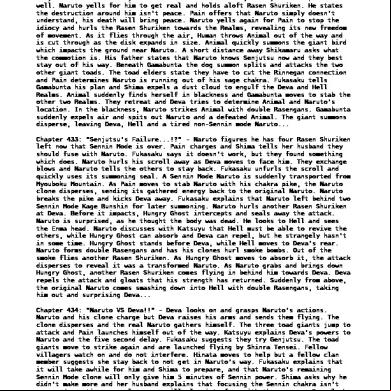The Intelligent Investor Chapter 3 k234k
This document was ed by and they confirmed that they have the permission to share it. If you are author or own the copyright of this book, please report to us by using this report form. Report 2z6p3t
Overview 5o1f4z
& View The Intelligent Investor Chapter 3 as PDF for free.
More details 6z3438
- Words: 715
- Pages: 2
The Intelligent Investor Chapter 3: A Century of Stock-‐Market History: The Level of Stock Prices in Early 1972 • • • •
•
•
•
•
The intelligent investor should have a solid understanding of stock-‐market history Price levels and their relationship to earnings and dividends paid are of paramount importance This background information gives the investor the ability to gauge the attractiveness of the current market level A chart is displayed of the Dow Jones Industrial Average and the S&P 500 from 1871 through 1972 • In only two of the nine decades shown did corporate earnings decrease • There were no decades where average dividend yields decreased • Growth rates varied significantly in many of the decades studied Valuation levels and dividend yield also fluctuated wildly • The S&P traded at 6.3 times earnings in 1949 and rose to 22.9 times earnings in 1961 • Dividend yield was 7% in 1949 and 3% in 1961 Graham ultimately concluded that the market was expensive in 1972 for two reasons • The price to earnings ratio of 18.0 was high by historical standards • The yield available on common stocks was less than half of the available yield on high quality bonds Based on his conclusion that the market was overvalued he recommended the following course of action • No borrowing to buy or hold securities • No increase in the proportion of funds held in common stocks • A reduction in common stock holdings where needed to bring it down to a maximum of 50% of the total portfolio Commentary on Chapter 3 • “You’ve got to be careful if you don’t know where your going, ‘cause you might not get there.” – Yogi Berra • Graham’s warnings of dangerous valuation levels in 1972 proved to prophetic as the market declined 37% during the bear market of 1973-‐1974 • He believed that the intelligent investor must never forecast the future by extrapolating the past • During the bull market of the 1990’s many of these lessons were completely forgotten § Forecasters argued that because stocks had returned 7% on average since 1802 that investors should expect that return regardless of what level they purchased common stocks § Some claimed that stocks “always” beat bonds over a 30 year period and as a result could be bought without paying attention to valuations as long as the investor planned to hold forever • The market crash in the early 2000’s proved that valuation levels always matter and should not be ignored • The problem with extrapolating past market returns is that it includes an inherent “survivorship bias” § This means that many past companies went bust and are not ed for when analyzing historical market returns § This leaves analysts with a hand full of exceptional companies that have survived to use as data points § For every Coca Cola there are twenty companies from previous eras that are no longer in existence
• • • •
• • • • • • •
•
Because the profits that companies can earn are finite the price that investors are willing to pay must also be finite If future returns are guaranteed to match successful past returns investors would bid up stocks to unsustainable levels Extrapolating rosy historical returns into the future is illogical and dangerous according to Graham The performance of the stock market relies on three factors § Real growth (the rise of companies earnings and dividends) § Inflationary growth (the general rise of prices throughout the economy) § Speculative growth or decline (any increase or decrease in the investing public’s appetite for stocks) Corporate earnings per share have grown 1.5% to 2% annually As we discussed in the last chapter 3% is a suitable inflation estimate Average dividend yield on the S&P 500 is currently 1.7% By totaling these three percentages the investor can find the expected return for common stocks Currently the expected return for common stocks would be 6.7% or 3.7% after inflation The only constant in markets is that they continue to surprise investors It is therefore extremely important for investors to be humble and realize that their forecasts and projections are far from certain In financial markets the worse the future looks the better it usually turns out to be
•
•
•
•
The intelligent investor should have a solid understanding of stock-‐market history Price levels and their relationship to earnings and dividends paid are of paramount importance This background information gives the investor the ability to gauge the attractiveness of the current market level A chart is displayed of the Dow Jones Industrial Average and the S&P 500 from 1871 through 1972 • In only two of the nine decades shown did corporate earnings decrease • There were no decades where average dividend yields decreased • Growth rates varied significantly in many of the decades studied Valuation levels and dividend yield also fluctuated wildly • The S&P traded at 6.3 times earnings in 1949 and rose to 22.9 times earnings in 1961 • Dividend yield was 7% in 1949 and 3% in 1961 Graham ultimately concluded that the market was expensive in 1972 for two reasons • The price to earnings ratio of 18.0 was high by historical standards • The yield available on common stocks was less than half of the available yield on high quality bonds Based on his conclusion that the market was overvalued he recommended the following course of action • No borrowing to buy or hold securities • No increase in the proportion of funds held in common stocks • A reduction in common stock holdings where needed to bring it down to a maximum of 50% of the total portfolio Commentary on Chapter 3 • “You’ve got to be careful if you don’t know where your going, ‘cause you might not get there.” – Yogi Berra • Graham’s warnings of dangerous valuation levels in 1972 proved to prophetic as the market declined 37% during the bear market of 1973-‐1974 • He believed that the intelligent investor must never forecast the future by extrapolating the past • During the bull market of the 1990’s many of these lessons were completely forgotten § Forecasters argued that because stocks had returned 7% on average since 1802 that investors should expect that return regardless of what level they purchased common stocks § Some claimed that stocks “always” beat bonds over a 30 year period and as a result could be bought without paying attention to valuations as long as the investor planned to hold forever • The market crash in the early 2000’s proved that valuation levels always matter and should not be ignored • The problem with extrapolating past market returns is that it includes an inherent “survivorship bias” § This means that many past companies went bust and are not ed for when analyzing historical market returns § This leaves analysts with a hand full of exceptional companies that have survived to use as data points § For every Coca Cola there are twenty companies from previous eras that are no longer in existence
• • • •
• • • • • • •
•
Because the profits that companies can earn are finite the price that investors are willing to pay must also be finite If future returns are guaranteed to match successful past returns investors would bid up stocks to unsustainable levels Extrapolating rosy historical returns into the future is illogical and dangerous according to Graham The performance of the stock market relies on three factors § Real growth (the rise of companies earnings and dividends) § Inflationary growth (the general rise of prices throughout the economy) § Speculative growth or decline (any increase or decrease in the investing public’s appetite for stocks) Corporate earnings per share have grown 1.5% to 2% annually As we discussed in the last chapter 3% is a suitable inflation estimate Average dividend yield on the S&P 500 is currently 1.7% By totaling these three percentages the investor can find the expected return for common stocks Currently the expected return for common stocks would be 6.7% or 3.7% after inflation The only constant in markets is that they continue to surprise investors It is therefore extremely important for investors to be humble and realize that their forecasts and projections are far from certain In financial markets the worse the future looks the better it usually turns out to be










